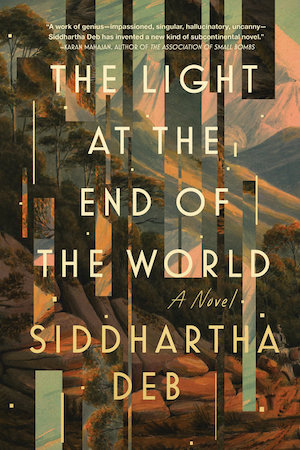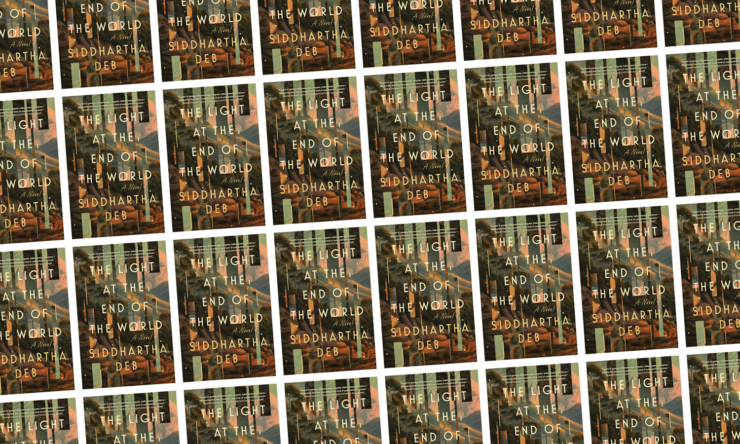I don’t normally recommend reading a novel while ill, but there’s something about Siddhartha Deb’s The Light at the End of the World that makes taking it in while in the midst of the slightly altered state that can come from a light sickness seem entirely fitting. Since we’re still early in the review, I should also stress that this is absolutely intended as a compliment.
On paper, Deb’s novel sounds familiar to other decades-spanning novels that blend the historic with the speculative, especially David Mitchell’s Cloud Atlas and Namwali Serpell’s The Old Drift. But Deb’s book throws an element of delirium into the mix—it’s here the “reading while sick” factor came into play—which takes this strange, sprawling novel into a territory of its own, one where its characters search for answers in an ever-shifting world, one where their relationship to themselves, the people around them, the structures of power, the weight of history, and the most familiar parts of their lives are all subject to rapid change and revision.
Buy the Book


The Light at the End of the World
The Light at the End of the World is divided into five sections, with the first and fifth set in a near-future Delhi. This is a milieu in which everything is in a state of flux. This includes money: “On a fogless but gloomy morning, Bibi discovers, via a text from Moi, that the money in her purse is no longer any good. All big denomination notes have been canceled and must be exchanged for new currency.”
Bibi herself works an ambiguous job at a company called Amidala for a mysterious man named S.S. Chakravarthy. That’s not meant in a Kafka-esque way; instead, ten pages into the novel, the narration itself states outright that Bibi is neither sure of what Amidala does nor what her position there entails. Gradually, she is tasked with tracking down a man she knew years ago. Bibi also contends with a series of found documents, one of which waxes ecstatically about the New Delhi Monkey Man, a bizarre phenomenon responsible for a series of attacks in 2001.
There’s a passage in a manuscript that Bibi reads that offers a hint of the novel’s structure to come:
“What if New Delhi Monkey Man was a mutant creature produced by the toxic gas cloud of Bhopal in 1984? What if New Delhi Monkey Man was an extraterrestrial creature, an alien accidentally marooned on this planet? What if New Delhi Monkey Man was a strange new mutation, an outcome of Artificial Intelligence stirring into consciousness in the aftermath of Y2K? What if New Delhi Monkey Man had time traveled from the past, coming at us from the Sepoy Rebellion of 1857 or from the killing fields of Partition in 1947?”
It will come as little surprise to learn that the novel’s remaining three segments are set in 1984, 1947, and 1857. Each follows a character as different from Bibi as they are from each other: The ruthless gun for hire in 1984 sharply contrasts the idealistic student at the heart of the 1947 passages, and both of them are substantially different from the British colonial soldier whose alienation takes on increasingly surreal dimensions as the 1857 segment proceeds towards its conclusion.
The 1857 segment is also the point where the more hallucinatory elements of the novel step forward out of the background and turn much of the novel’s subtext into text. And if aspects of this part of the novel feel like a riff on Andrei Tarkovsky’s Stalker, there’s a solid reason for that: Deb cited that film as an influence on this novel in a recent interview.
In that same interview, Deb addressed this novel’s overarching structure. “There are also some submerged plot lines running through all four sections, but these are for the readers to notice and to play with, if it comes across to them,” he said. And for me, what connects these different timeframes and these disparate characters are two things: the sense of societal upheaval that characters in all of them are experiencing and the questions of nationhood and nationalism put forth in each time period.
It’s with the latter that the novel’s more speculative and uncanny elements come to the foreground. New Delhi Monkey Man isn’t the only supernatural or science fictional aspect to The Light at the End of the World. This is a novel in which ancient airships might have the power to solve national disputes and where people undergo strange transformations. Plenty of nationalist rhetoric looks to the past as an idealized time when things were simpler; in the different times and places Deb describes here, the reverse is true. The past is always stranger than Deb’s characters expect—sometimes horrifyingly so.
The Light at the End of the World would make for an interesting double bill with Vladimir Sorokin’s Ice Trilogy, another maximalist work of fiction in which a nation’s most reactionary tendencies are juxtaposed with a past that’s far weirder than any of said reactionaries would care to admit. At times, the novel’s hallucinatory and historical qualities can clash, and its malleable reality can make it challenging to parse the finer details of what is happening during certain moments. But that hallucinatory quality makes this novel far more effective than a more buttoned-down narrative style would have. It’s a heady trip into the unexpected, and one whose transformations and contradictions make for a searingly effective narrative.
The Light at the End of the World is published by Soho Press.
Read an excerpt.
 Tobias Carroll is the managing editor of Vol.1 Brooklyn. He is the author of the short story collection Transitory (Civil Coping Mechanisms) and the novel Reel (Rare Bird Books).
Tobias Carroll is the managing editor of Vol.1 Brooklyn. He is the author of the short story collection Transitory (Civil Coping Mechanisms) and the novel Reel (Rare Bird Books).










